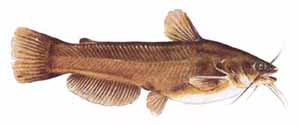Yellow Bullhead (Ameiurus natalis)
- Other Names
- Mudcat, Polliwog, Chucklehead Cat
- Description
- Ameiurus means "primitive or curtailed" in reference to the notch in the distal end of the caudal fin, and natalis is Latin for "having large buttocks." Yellow bullheads are typically light yellow to olive-green on the back, often somewhat mottled. The belly is yellowish to white. The tail is not notched, and may be slightly rounded. Chin barbels are white. The anal fin has 23-27 rays.
- Life History
- During late spring or early summer, yellow bullheads excavate nests in mud bottoms and spawn. Both parents guard the nest, which may contain 2,000 to 12,000 eggs. In four to six days eggs hatch and fry begin to school in compact balls which are guarded by adults until individuals reach about one inch in length. Like the black bullhead, the yellow bullhead is omnivorous, feeding on a variety of plant and animal material, both live and dead. Immature aquatic insects and crustaceans often comprise a considerable proportion of the diet. Although yellow bullheads rarely achieve edible size, some individuals may exceed four pounds.
- Distribution
- Yellow bullheads range throughout the central and eastern US from central Texas north into North Dakota and east through the Great Lakes region to the coast. The species is found throughout Texas with the exclusion of the Trans-Pecos and Panhandle drainages.
- Other
- Like black bullheads, yellow bullheads are not generally considered an important gamefish in Texas, though they are readily fished for by anglers in the Panhandle, and in far East Texas. Angling techniques for the two species are very similar. The largest specimen reported to date in Texas was 5.59 pounds.
